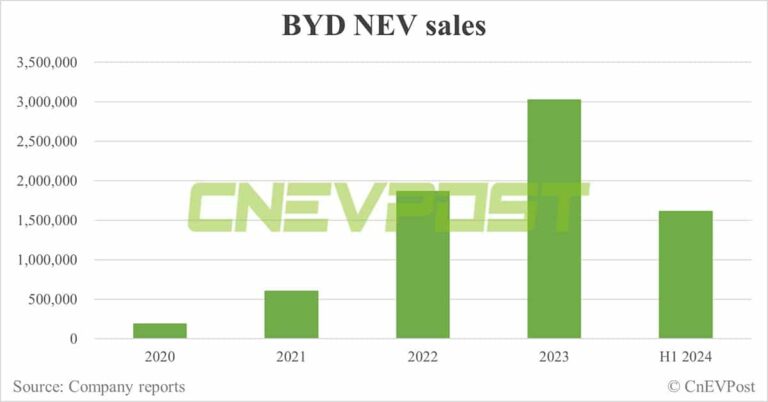BYD has launched the 2025 Seal and the new Seal 07 DM-i, both based on its latest technology architecture. The 2025 Seal is BYD's first model to feature LiDAR.

BYD (HKG: 1211, OTCMKTS: BYDDY) has rolled out two new models in its Seal lineup and has begun to adopt LiDAR to provide enhanced driver assistance capabilities.
The Chinese new energy vehicle (NEV) maker launched the 2025 Seal and the new Seal 07 DM-i at an event today, further expanding the product offerings of the sedan series.
The Seal series covers the range of RMB 100,000 to RMB 300,000, and future models will include the Seal 05, Seal 06, Seal 07, Seal 08, and Seal 09 product series, said Zhang Zhuo, general manager of sales for BYD's Ocean produce line.
The Seal series currently includes the 2025 Seal EV, Seal 07 DM-i, Seal 06 DM-i, and Seal DM-i Glory Edition.
2025 Seal EV
The 2025 Seal EV is the first sedan model of BYD's e-Platform 3.0 Evo architecture -- an upgraded version of e-Platform 3.0, the company's battery electric vehicle (BEV) platform.
BYD unveiled the e-Platform 3.0 Evo on May 10, along with the first model based on the new platform, the Sealion 07 EV, an SUV (sport utility vehicle). This new platform has higher integration, more powerful powertrain performance, and charging performance.
The 2025 Sealion EV is based on the 800 V high-voltage platform, which offers faster charging and better energy performance than its predecessor's 400 V platform.
The BEV is offered in four variants with a starting price of RMB 175,800 ($24,510), RMB 189,800, RMB 216,800 and RMB 239,800, respectively.
The two highest-priced variants come with LiDAR, making the Seal EV the first BYD model to feature the component.
It's worth noting that while NEVs have started to contribute half of China's monthly new car sales, carmakers are still divided over whether to adopt LiDAR.
None of Tesla's (NASDAQ: TSLA) models feature LiDAR, with its latest driver assistance system relying on a purely visual solution.
Xpeng (NYSE: XPEV) was the world's first to use LiDAR in a production vehicle, but CnEVPost exclusively reported last month that it will begin ditching LiDAR in favor of a pure vision solution in its P7+sedan, codenamed F57.
The 2025 Seal EV with LiDAR will feature BYD's in-house developed DiPilot 300 assisted driving system, capable of point-to-point pilot-assisted driving on highways and urban roads.

In urban areas, the DiPilot 300 system can be enabled on any road, BYD said at today's launch event.
The 2025 Seal EV measures 4,800 mm in length, 1,875 mm in width and 1,460 mm in height, with a wheelbase of 2,920 mm.
The three lowest-priced variants are all single-motor rear-wheel drive models that can accelerate from 0 to 100 km/h in as fast as 5.9 seconds. The highest-priced dual-motor four-wheel drive model can accelerate from 0 to 100 km/h in 3.8 seconds.
The model is powered by BYD's signature blade battery based on lithium iron phosphate chemistry, with the lowest priced variant having a pack capacity of 61.44 kWh and capable of delivering a CLTC range of 510 kilometers.
The other three variants all have a pack capacity of 80.64 kWh and are capable of delivering a CLTC range of either 650 km or 600 km.
The BYD Seal was initially launched in China on July 29, 2022, when it was only available in BEV versions, and was seen as one of the strongest rivals of the Tesla Model 3 in China.
On September 6, 2023, BYD launched the hybrid Seal DM-i, expanding the Seal lineup. On May 28 this year, BYD launched the Seal 06 DM-i with the latest DM 5.0 technology as a new addition to the Seal series.
BYD originally wanted to rename the 2025 Seal EV to Seal 07 EV, however, after receiving feedback from its community, the Seal EV name was retained.
Seal 07 DM-i

The hybrid Seal 07 DM-i is an all-new model with BYD's fifth-generation DM technology, the first mid to large-size sedan to feature it.
BYD launched its DM 5.0 hybrid technology on May 28, allowing for lower fuel consumption. The mid-size sedans Seal 06 DM-i and Qin L DM-i are the first two to come with the technology, both with a combined range of more than 2,000 kilometers.
The Seal 07 DM-i is available in five variants with starting prices of RMB 139,800, RMB 155,800, RMB 165,800, RMB 175,800 and RMB 195,800, respectively.
It has a length, width and height of 4,980 mm, 1,890 mm, 1,495 mm, respectively, and a wheelbase of 2,900 mm.
The most expensive variant of the hybrid sedan is powered by a 1.5T engine with a maximum power of 115 kW and a front electric motor with a maximum power of 200 kW, which can accelerate from 0 to 100 km/h in 6.9 seconds.
The other four variants are powered by a 1.5L engine with a maximum power of 74 kW and a front electric motor with a maximum power of 160 kW, and can accelerate from 0 to 100 km/h in 8.0 seconds or 8.5 seconds.
The Seal 07 DM-i is powered by BYD's blade batteries, with the lowest priced variant having a pack capacity of 10.08 kWh, which provides a CLTC battery range of 70 km.
The other four variants carry a pack with a capacity of 17.6 kWh and all have a CLTC battery range of 125 kilometers.
The Seal 07 DM-i comes standard with DiPilot driver assistance system, capable of providing L2 driver assistance.
BYD is already the largest NEV maker in China, and the launch of the two new models in the Seal range is expected to help it further increase sales.
In January-July, BYD sold 1,955,366 NEVs, up 28.83 percent year-on-year, according to data compiled by CnEVPost.
The Seal series sold 113,819 vehicles in January-July, up 134.94 percent year-on-year, contributing 5.82 percent of BYD's sales in the same period.

($1 = RMB 7.1725)





